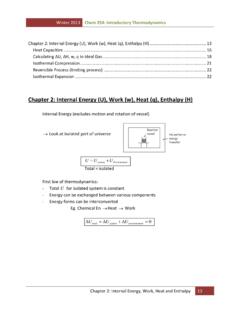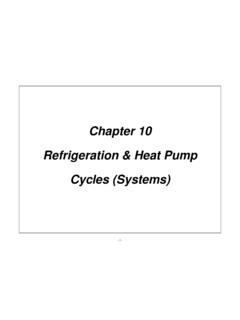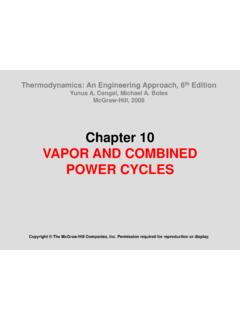Chapter 10 Temperature And Heat
Found 9 free book(s)Chapter 2: Internal Energy (U), Work (w), Heat (q ...
scienide2.uwaterloo.caChapter 2: Internal Energy, Work, Heat and Enthalpy 13 ... The amount of energy (heat) required to raise the temperature of 1 gram of substance by 1 oC. Heat capacity of water is 4.18 J/g K = 1 calorie 1) Heat capacity is dependent on heat Eg. 10 oC o 11 oC and 80 oC o
Chapter 10 Refrigeration & Heat Pump Cycles (Systems)
www.descoenergy.comChapter 10 Refrigeration & Heat Pump Cycles (Systems) - 2 - Refrigeration & Heat Pump Systems • To maintain a region of space at a temperature blow that of ... the condenser of a low-temperature cycle provides the heat input to the evaporator of a …
Chapter 17 SOLAR ENERGY - Pennsylvania State University
personal.ems.psu.edudefinition of heat (Chapter 3): Heat = [Mass] [Heat capacity] [Temperature difference] Here the mass is that of the storage medium, water, which needs to be determined. The heat capacity of water is 1 kcal/kg/°C (see Table 3-2), and the temperature difference is that between the hot fluid in the secondary loop and the cold water going into the ...
Chapter 2 Measurement of Temperature
www.jma.go.jpChapter 2 Measurement of Temperature 2.1 Definition and units Heat balance difference of atmosphere between regions creates temperature distribution. This temperature distribution generates wind current along with cloud and rainfall phenomena. Thus, atmospheric temperature is one of the most important meteorological elements as well as wind and
Chapter 10 VAPOR AND COMBINED POWER CYCLES
staff.emu.edu.trThe first part of the heat-addition process in the boiler takes place at relatively low temperatures. Heat is transferred to the working fluid during process 2-2’ at a relatively low temperature. This lowers the average heat-addition temperature and thus the cycle efficiency. In steam power plants, steam is extracted
STEADY HEAT CONDUCTION
www.cecs.wright.eduarea, and the temperature difference, but is inversely proportional to the wall thickness.Also, once the rate of heat conduction is available, the tem-perature T(x) at any location x can be determined by replacing T 2 in Eq. 3–3 by T, and L by x. Thermal Resistance Concept Equation 3–3 for heat conduction through a plane wall can be ...
Chapter 14 Sterile Filtration, Filling, and Lyophilization ...
biomanufacturing.org4 Chapter 14 – Sterile Filtration, Filling, and Lyophilization of Product Eutectic: two or more crystalline species in such close contact that they melt as a single, pure substance Eutectic melt: the characteristic temperature where a eutectic solid melts Flexible IV (intravenous) bags: a sterile bag used to hold fluids that are administered to a ...
Chapter 15: EXPLOSIVES DEFINITIONS
www.ilo.orgChapter 15: EXPLOSIVES DEFINITIONS 1. An explosive substance is a solid or liquid substance (or mixture of substances) which is in itself capable by chemical reaction of producing gas at such a temperature and pressure and at such a speed as to cause damage to the surroundings. Pyrotechnic substances are included even when they do not evolve gases.
Chapter 5: Microbial Metabolism
www.lamission.edu2) Changes in temperature, pH or [salt] 3) Availability of any necessary cofactors 4) Effect of inhibitors • more enzyme &/or more substrate = more product! • can effect enzyme structure, hence its activity • some enzymes don’t work w/o a non-protein cofactor • molecules that bind to enzymes & reduce their activity








